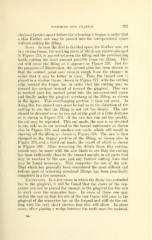Page 605 - My FlipBook
P. 605
FINISHING GOLD FILLINGS. 293
strained farther apart before the trimming is begun in order that
a thin Koeber saw may be passed into the interproximal space
without cutting the filling.
Saws. In ease the first is decided upon, the Koeber saw, set
in a strong frame, the working parts of which are shown enlarged
in Figure 375, is passed between the filling and the proximating
tooth, cutting the least amount possible from the filling. This
cut will leave the filling as it appears in Figure 376. But for
the purposes of illustration, the second plan has been chosen so
that the contact point may remain rough from the plugger in
order that it may be better in view. Then the thread saw is
placed in a similar frame, shown in Figure 377, with the cutting
edge toward the frame bar in order that the cutting may be
toward the occlusal instead of toward the gingival. This saw
is worked past the contact point into the interproximal space
and finally under the gingival overhang of the filling, as shown
in the figure. This overhanging portion is then cut away. In
doing this the utmost care must be had as to the direction of the
cutting to see that the filling is not cut too deeply. The saw
should be directed so as to run out of the gold at a little distance
as is shown in Figure 378. If the saw has run out too quickly,
the cut may be repeated. This cut made, the saw is so strained
to one side as to cut around to the buccal embrasure as shown
also in Figure 378, and another cut made, which will result in
shaving off the filling as shown in Figure 379. The saw is then
changed to the lingual portion of the filling, as shown also in
Figure 379, and a third cut made, the result of which is shown
in Figure 380. After removing the debris from this cutting,
search may be made with the saw blade to see that the cutting
has been sufficiently close to the enamel margin in all parts that
may be reached by the saw, and any further cutting done that
may be found necessary. This completes the use of the saw.
That which has generally been considered the most difficult and
tedious part of trimming j^roximal fillings has been practically
completed in a few moments.
Exceptions. In a few cases in which the decay has extended
far to the gingival, it will be found that the claws of the sep-
arator can not be placed far enough to the gingival for the saw
to work over the separator bars. In some of these one may
incline the saw so that the nib of the saw frame will pass to the
gingival of the separator bar on the lingual and still do the cut-
ting with the very short strokes that this will allow. In other
cases, after placing a wedge between the teeth near the occlusal^
39a


